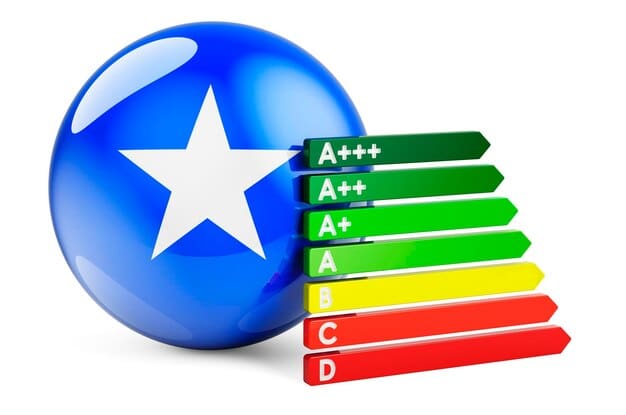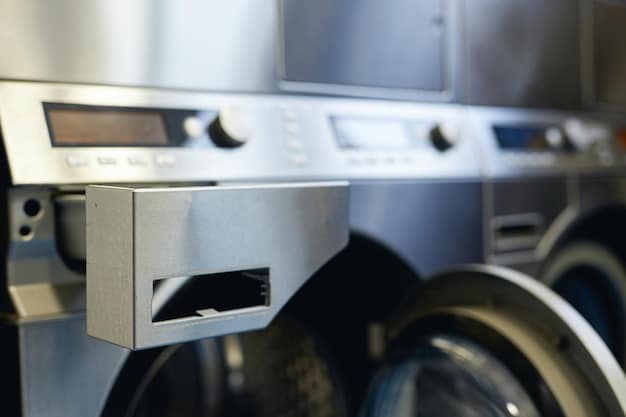Energy-Efficient Appliances: Save $250/Year Guide

Energy-efficient appliances can significantly reduce your utility bills and environmental impact; by making informed choices when purchasing new appliances, you can save approximately $250 per year and contribute to a greener lifestyle.
Are you looking to reduce your carbon footprint while also saving money on your energy bills? Choosing energy-efficient appliances is a smart move. This guide will show you how to select the right models and potentially save up to $250 per year.
Understanding Energy Efficiency Ratings
Navigating the world of appliances can be confusing, especially when trying to decipher energy efficiency ratings. Understanding these ratings is crucial for making informed decisions.
The Energy Star label is a key indicator of energy efficiency. But what does it really mean?
What is the Energy Star Label?
The Energy Star label is a government-backed symbol for energy efficiency. Appliances with this label meet strict energy-saving guidelines set by the Environmental Protection Agency (EPA).
Looking for the Energy Star label can help you quickly identify appliances that will consume less energy.
How to Read EnergyGuide Labels
EnergyGuide labels provide estimated annual energy consumption and operating costs. Understanding these labels can help you compare different models and choose the most efficient option.
- Look for the estimated annual energy consumption: This tells you how much energy the appliance is expected to use in a year.
- Compare operating costs: This shows how much it will cost to run the appliance annually.
- Check the range: See how the appliance compares to other similar models in terms of energy efficiency.

Understanding these labels empowers you to make smarter choices and potentially save money on your energy bills.
By paying attention to energy efficiency ratings and labels, you can make informed decisions that benefit both your wallet and the environment.
Refrigerators: Keeping it Cool and Efficient
Refrigerators are essential appliances, but they can also be energy hogs. Choosing an energy-efficient refrigerator can lead to significant savings.
Here’s what to consider when selecting an energy-efficient refrigerator.
Types of Energy-Efficient Refrigerators
Different types of refrigerators consume varying amounts of energy. Consider these options:
- Top-freezer refrigerators: Generally more energy-efficient than side-by-side or bottom-freezer models.
- Bottom-freezer refrigerators: Offer good energy efficiency and convenient access to the refrigerator compartment.
- Side-by-side refrigerators: Tend to be less energy-efficient due to their larger size and through-the-door features.
Features That Enhance Efficiency
Certain features can improve a refrigerator’s energy efficiency:
Adjustable shelves and compartments allow for better organization, reducing the need to search for items and keeping the door open for shorter periods.
Automatic defrost minimizes frost buildup, which can reduce efficiency. Look for models with adaptive defrost, which only defrost when necessary.
Proper maintenance can also improve efficiency. Regularly cleaning the refrigerator and ensuring door seals are tight can help save energy.
Choosing the right type of refrigerator and looking for energy-efficient features can significantly reduce your energy consumption.
Washing Machines and Dryers: Smart Laundry Practices
Laundry appliances are another area where energy efficiency can make a big difference. Efficient washing machines and dryers not only save energy but also water.
Here’s how to choose the most energy-efficient models for your laundry room.
High-Efficiency Washing Machines
High-efficiency (HE) washing machines use less water and energy compared to traditional models. Look for these features:
- Front-load washers: Generally more energy-efficient than top-load models because they use less water.
- Energy Star certification: Ensures the washer meets strict energy-saving guidelines.
- Water factor: Lower water factor indicates better water efficiency.
Energy-Efficient Dryers
Dryers can be energy-intensive, but new models offer improved efficiency. Consider these factors:
Sensor dryers automatically detect when clothes are dry and stop the cycle, preventing over-drying and saving energy.
Proper venting ensures efficient drying. Clean the lint trap after each load to maintain airflow and prevent fire hazards.
Air drying is also a great way to save energy. When possible, hang clothes outside or use a drying rack indoors.

By selecting energy-efficient washing machines and dryers and adopting smart laundry practices, you can significantly reduce your energy and water consumption.
Dishwashers: Saving Water and Energy After Meals
Dishwashers can save time and water compared to handwashing, but it’s important to choose an energy-efficient model.
Here’s how to select an energy-efficient dishwasher that fits your needs.
Key Features of Energy-Efficient Dishwashers
Energy-efficient dishwashers come with features designed to minimize water and energy usage:
Soil sensors adjust the wash cycle based on the amount of food residue, saving water and energy.
Energy Star certified dishwashers meet strict energy-saving guidelines and can save water and energy.
Consider dishwashers with adjustable racks to accommodate different types of dishes. This can help you maximize each load and reduce the number of cycles needed.
Tips for Efficient Dishwashing
Proper usage can also improve a dishwasher’s efficiency:
- Load efficiently: Maximize each load by arranging dishes properly to ensure they are cleaned effectively.
- Use the economy cycle: This cycle uses less water and energy for lightly soiled dishes.
- Skip pre-rinsing: Most modern dishwashers can effectively clean dishes without pre-rinsing, saving water and energy.
Choosing an energy-efficient dishwasher and following smart dishwashing practices can help you save water, energy, and time.
Lighting: Switching to LEDs
Lighting is a significant energy consumer in many homes. Switching to energy-efficient lighting, such as LEDs, can make a big difference.
Here’s why LEDs are a smart choice and how to maximize their benefits.
Benefits of LED Lighting
LEDs offer numerous advantages over traditional incandescent bulbs:
LEDs use up to 75% less energy than incandescent bulbs, saving you money on your energy bills.
- Long lifespan: LEDs last much longer than incandescent bulbs, reducing the need for frequent replacements.
- Lower heat output: LEDs produce less heat, which can help reduce cooling costs in the summer.
- Versatility: LEDs come in various colors and styles, suitable for different lighting needs.
Choosing the Right LEDs
When selecting LEDs, consider these factors:
Look for LEDs with the Energy Star label to ensure they meet energy efficiency standards.
Understand the color temperature of the light. Soft white (2700-3000K) is suitable for living rooms and bedrooms, while cool white (3500-4100K) is better for kitchens and offices.
Ensure the LED bulb is compatible with your fixture. Some LEDs may not work with dimmer switches.
Switching to LEDs is a simple and effective way to reduce your energy consumption and save money.
Additional Tips for Saving Energy
Beyond choosing energy-efficient appliances, there are many other ways to reduce your energy consumption and save money.
Here are some additional tips to consider.
Smart Thermostats
Smart thermostats can automatically adjust the temperature based on your schedule and preferences. They can learn your habits and optimize energy usage, saving you money on heating and cooling costs.
Programmable thermostats allow you to set different temperatures for different times of the day. This can help you save energy when you’re not at home or when you’re sleeping.
Power Strips and Phantom Loads
Many electronic devices continue to draw power even when they’re turned off. This is known as phantom load. Using power strips can help you eliminate phantom loads by easily switching off multiple devices at once.
Unplug chargers and devices when they’re not in use. This simple habit can save energy and reduce your electricity bill.
By adopting these additional energy-saving tips, you can further reduce your energy consumption and save money on your utility bills.
| Key Point | Brief Description |
|---|---|
| 💡 Energy Star | Look for the Energy Star label to ensure appliances meet energy-saving standards. |
| 💧 Water Factor | Choose washing machines with a lower water factor for better water efficiency. |
| 🌡️ Smart Thermostats | Use smart thermostats to automatically adjust temperature and save energy. |
| 🔌 Power Strips | Use power strips to eliminate phantom loads from electronic devices. |
Frequently Asked Questions
▼
Savings vary, but upgrading to energy-efficient appliances can save you approximately $250 per year on your energy bills by reducing overall energy consumption.
▼
The Energy Star label is a government-backed symbol for energy efficiency, indicating that an appliance meets strict energy-saving guidelines set by the EPA, ensuring lower energy consumption.
▼
Yes, front-load washers are generally more energy-efficient than top-load washers because they use less water per load, leading to reduced energy usage.
▼
Smart thermostats save energy by automatically adjusting the temperature based on your schedule, learning your habits, and optimizing energy usage for heating and cooling.
▼
Phantom loads are energy drawn by devices when turned off. Eliminate them by using power strips to switch off multiple devices at once and unplugging chargers when not in use.
Conclusion
Choosing energy-efficient appliances is a significant step towards reducing your environmental impact and saving money on your energy bills by potentially saving up to $250 each year. By understanding energy efficiency ratings, selecting the right models, and adopting smart energy-saving practices, you can create a more sustainable and cost-effective home.





